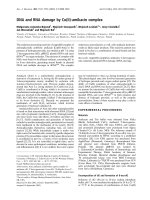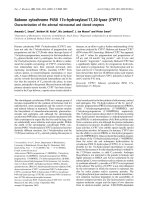Báo cáo y học: " Gingival and plaque decontamination: Can we take a bite out of VAP" potx
Bạn đang xem bản rút gọn của tài liệu. Xem và tải ngay bản đầy đủ của tài liệu tại đây (105.96 KB, 2 trang )
Available online at
Evidence-Based Medicine Journal Club
EBM Journal Club Section Editor: Eric B. Milbrandt, MD, MPH
Journal club critique
Gingival and plaque decontamination: Can we take a bite out of VAP?
Jatinder Somal
1
and Joseph M. Darby
2
1
Clinical Fellow, Department of Critical Care Medicine, University of Pittsburgh School of Medicine, Pittsburgh, Pennsylvania, USA
2
Professor, Department of Critical Care Medicine, University of Pittsburgh School of Medicine, Pittsburgh, Pennsylvania, USA
Published online: 7
th
August 2006
This article is online at
© 2006 BioMed Central Ltd
Critical Care 2006, 10:312 (DOI 101186/cc4999)
Expanded Abstract
Citation
Fourrier F, Dubois D, Pronnier P, Herbecq P, Leroy O,
Desmettre T, Pottier-Cau E, Boutigny H, Di Pompeo C,
Durocher A, Roussel-Delvallez M: Effect of gingival and
dental plaque antiseptic decontamination on nosocomial
infections acquired in the intensive care unit: a double-blind
placebo-controlled multicenter study. Crit Care Med 2005,
33:1728-1735 [1].
Background
Poor oral hygiene and colonization of dental plaque is likely
to play an important role in the development of ventilator-
associated pneumonia (VAP) in many critically ill patients.
Preliminary observations have suggested that dental plaque
antiseptic decontamination (PAD) may reduce the frequency
of VAP and ICU acquired bacteremia.
Methods
Design and setting: Prospective, multi-center, double-
blind, placebo-controlled trial in six French ICUs.
Objective: To document the effect of gingival and dental
plaque antiseptic decontamination on the rate of nosocomial
bacteremias and respiratory infections acquired in the ICU.
Patients and intervention: 228 non-edentulous patients
requiring endotracheal intubation and mechanical ventilation
with an anticipated ICU length of stay > 5 days were
randomized to receive 0.2% chlorhexidine gel or placebo
applied to dental and gingival surfaces three times daily for
the duration of their ICU stay until day 28.
Outcomes: The primary end point was the composite
incidence of bacteremia, bronchitis and VAP acquired in the
ICU. Secondary endpoints included ICU mortality, length of
stay and medical and nursing care loads. Changes in
bacterial colonization were evaluated in a subset of
randomized patients.
Results
All baseline characteristics were similar between the treated
and the placebo groups. The trial was stopped based on an
interim analysis showing statistical futility. The incidence of
nosocomial infections was 17.5% (13.2 per 1000 ICU days)
in the placebo group and 18.4% (13.3 per 1000 ICU days)
in the plaque antiseptic decontamination group (p=NS). No
difference was observed in the incidence of ventilator-
associated pneumonia per ventilator or intubation days,
mortality, length of stay, and care loads. On day 10, the
number of positive dental plaque cultures was significantly
lower in the treated group (29% vs. 66%; p<0.05). Highly
resistant Pseudomonas, Acinetobacter, and Enterobacter
species identified in late-onset ventilator-associated
pneumonia and previously cultured from dental plaque were
not eradicated by the antiseptic decontamination. No side
effect was reported.
Conclusion
Gingival and dental plaque antiseptic decontamination
significantly decreased the oropharyngeal colonization by
aerobic pathogens in ventilated patients. However, its
efficacy was insufficient to reduce the incidence of
respiratory infections due to multiresistant bacteria.
Commentary
VAP remains a major cause of morbidity, mortality, and
increased costs in the ICU [2]. Recent clinical practice
guidelines recommend a variety of preventative measures,
including orotracheal (rather than endotracheal) intubation,
closed suctioning systems, weekly changes of heat and
moisture exchangers, semi-recumbent positioning, and
subglottic secretion drainage [3]. Although evidence from
more than 50 clinical trials and ten meta-analyses
demonstrate that selective decontamination of the digestive
tract (SDD) using topical antibiotics (+/- systemic
antibiotics) is associated with decreased incidence of VAP,
routine implementation of SDD has not been adopted by
most intensivists because of concerns about the emergence
of antibiotic-resistant pathogens. Topical application of an
antiseptic, such as chlorhexidine, could be an attractive
alternative for oropharyngeal decontamination. For
example, chlorhexidine oral decontamination reduced the
incidence of VAP in a low-risk population of cardiac surgical
patients [4] and, recently, in mechanically ventilated
medical-surgical ICU patients [5].
Page 1 of 2
(page number not for citation purposes)
Critical Care Vol 10 No 4 Somal and Darby
Colonization of the oropharynx by pathogenic bacteria is a
key step in the development of VAP. Poor oral hygiene and
excess dental plaque are particularly troublesome sources
of nosocomial infection. Notably, a single mm
3
of dental
plaque contains ≥10
8
bacteria! Preliminary observations
indicate that dental plaque antiseptic decontamination
(PAD), in which an antiseptic is applied directly to dental
and gingival surfaces, may reduce the frequency of VAP
and ICU-acquired bacteremia [6].
In this randomized controlled trial by Fourrier and
colleagues [1], PAD with 0.2% chlorhexidine gel had no
apparent impact on the incidence of VAP, bronchitis, or
bacteremia. While eradication of bacteria from these areas
might be expected to reduce oropharyngeal colonization
and subsequent pneumonia, a number of methodological
limitations may have reduced the likelihood of showing an
impact for the intervention. Because rates of VAP were
much lower than anticipated, the study was underpowered.
Two-thirds of the subjects were considered infected at the
time of ICU admission (primarily bronchitis and community-
acquired pneumonia) and prior antibiotic usage was not an
exclusionary criterion for entry into the study, making
interpretation of rates of new respiratory infections
challenging at best. Failure to employ adjunctive mechanical
debridement of dental plaque (i.e., tooth brushing) and to
standardize recommended VAP prevention measures may
have further obscured any potentially beneficial effect of
PAD.
Despite the negative results of this study, some interesting
and potentially important observations emerged. These
observations serve to emphasize the potential role of poor
dental hygiene in the pathogenesis of VAP. Poor dental
hygiene was apparent in 90% of the patients at the time of
enrollment into the study. Of the 50% of dental plaque
cultures that were positive for bacterial growth at the time of
entry, approximately one third grew pathogenic aerobic
Gram-negative rods. There was good concordance of dental
plaque isolates with lung cultures in those who developed
respiratory infection. These findings add to the growing
body of evidence implicating poor oral hygiene as an
important risk factor in the development of VAP in critically
ill patients [7,8] and should serve to refocus our attention on
the teeth and oropharynx as a reservoir for bacterial
pathogens in transit to the lungs. Though the authors were
not able to show a meaningful clinical benefit in this study,
reducing bacterial colonization through PAD may still have
the potential to favorably impact VAP, perhaps when
coupled with other VAP preventative measures.
Further clinical investigations are needed to address a
number of outstanding questions and issues related to oral
hygiene and VAP prevention. The development of simple
and reproducible methods and tools to assess and define
the state of dentition, oral hygiene, and bacterial burden
would be of great value not only for research purposes but
also for the integration of oropharyngeal care into routine
clinical practice. Endotracheal tube fixation devices should
be designed not only to enhance tube security but also to
allow for easy access to the oropharynx without the need for
removing them each time oral hygiene care is administered.
Additional prospective studies are needed to identify oral
hygiene strategies that are the most effective in taking a bite
out of VAP!
Recommendation
Though the authors failed to show a benefit for
chlorhexidine-based PAD, other randomized controlled
studies have established that oral decontamination with
topical antiseptics reduces the incidence of VAP [4,5,9].
Interventions to establish and maintain good oral hygiene in
intubated patients should be part of a multifaceted approach
to the prevention VAP.
Competing interests
The authors declare no competing interests.
References
1. Fourrier F, Dubois D, Pronnier P, Herbecq P, Leroy O,
Desmettre T, Pottier-Cau E, Boutigny H, Di Pompeo C,
Durocher A, Roussel-Delvallez M: Effect of gingival
and dental plaque antiseptic decontamination on
nosocomial infections acquired in the intensive care
unit: a double-blind placebo-controlled multicenter
study. Crit Care Med 2005, 33:1728-1735.
2. Safdar N, Dezfulian C, Collard HR, Saint S: Clinical
and economic consequences of ventilator-
associated pneumonia: a systematic review. Crit
Care Med 2005, 33:2184-2193.
3. Dodek P, Keenan S, Cook D, Heyland D, Jacka M,
Hand L, Muscedere J, Foster D, Mehta N, Hall R, Brun-
Buisson C: Evidence-based clinical practice
guideline for the prevention of ventilator-associated
pneumonia. Ann Intern Med 2004, 141:305-313.
4. DeRiso AJ, Ladowski JS, Dillon TA, Justice JW,
Peterson AC: Chlorhexidine gluconate 0.12% oral
rinse reduces the incidence of total nosocomial
respiratory infection and nonprophylactic systemic
antibiotic use in patients undergoing heart surgery.
Chest 1996, 109:1556-1561.
5. Koeman M, van der Ven AJ, Hak E, Joore HC,
Kaasjager K, de Smet AG, Ramsay G, Dormans TP,
Aarts LP, de Bel EE, Hustinx WN, van dT, I, Hoepelman
AM, Bonten MJ: Oral decontamination with
chlorhexidine reduces the incidence of ventilator-
associated pneumonia. Am J Respir Crit Care Med
2006, 173:1348-1355.
6. Fourrier F, Cau-Pottier E, Boutigny H, Roussel-Delvallez
M, Jourdain M, Chopin C: Effects of dental plaque
antiseptic decontamination on bacterial colonization
and nosocomial infections in critically ill patients.
Intensive Care Med 2000, 26:1239-1247.
7. Brennan MT, Bahrani-Mougeot F, Fox PC, Kennedy TP,
Hopkins S, Boucher RC, Lockhart PB: The role of oral
microbial colonization in ventilator-associated
pneumonia. Oral Surg Oral Med Oral Pathol Oral
Radiol Endod 2004, 98:665-672.
8. Garcia R: A review of the possible role of oral and
dental colonization on the occurrence of health
care-associated pneumonia: underappreciated risk
and a call for interventions. Am J Infect Control 2005,
33:527-541.
9. Seguin P, Tanguy M, Laviolle B, Tirel O, Malledant Y:
Effect of oropharyngeal decontamination by
povidone-iodine on ventilator-associated
pneumonia in patients with head trauma. Crit Care
Med 2006, 34:1514-1519.
Page 2 of 2
(page number not for citation purposes)









